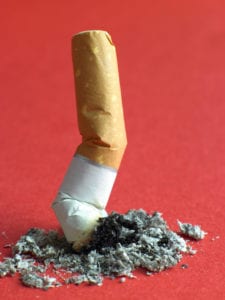Learn to be…tobacco-free. St. Charles Hospital’s Wisdom Conference Center, 200 Belle Terre Road, Port Jefferson will host a free 7-class tobacco cessation program on Jan. 9, 16, 23, 30, Feb. 6, Feb. 13 and Feb. 27 from 6 p.m. to 7:30 p.m. Make your New Year’s resolution now! For more information or to register, please call 631-853-2928 or 631-853-3162.
Smoking
Medical Compass: Abdominal aortic aneurysms — The silent killer
Lifestyle changes can reduce your risk
By David Dunaief, M.D.

Aneurysms are universally feared; they can be lethal and most times are asymptomatic (without symptoms). Yet aneurysms are one of the least well-covered medical disorders in the press. There are numerous types of aneurysms, most of which are named by their location of occurrence, including abdominal, thoracic and cerebral (brain). In this article, I will discuss abdominal aortic aneurysms, better known as a “triple-A,” or AAA. Preventing any type of aneurysm should be a priority.
What is an AAA? It is an increase in the diameter of the walls of the aorta in one area, in this case, the abdomen. The aorta is the “water main” for supplying blood to the rest of the body from the heart. Abnormal enlargement weakens the walls and increases the risk that it may rupture. If the aorta ruptures, it causes massive hemorrhaging, or bleeding, and creates a substantial likelihood of death.
The exact incidence of aneurysms is difficult to quantify, since some people may die due to its rupture without having an autopsy; however, estimates suggest that they occur in 4 to 9 percent of the population (1).
The cause of AAA is not known, but it is thought that inflammation and oxidative stress play an important role in weakening smooth muscle in the aorta (2). The consequence of this is an abnormally enlarged aorta.
People who are at highest risk for aneurysms are those over age 60 (3). Other risk factors include atherosclerosis, or hardened arteries; high blood pressure; race (Caucasian); gender (male); family history; smoking; and having a history of aneurysms in other arteries (4). Some of these risk factors are modifiable, such as atherosclerosis, high blood pressure and smoking.
Men are more than four times more likely to have an AAA (5). Though males are at a higher risk, women are at a higher risk of having an AAA rupture (6). So, gender is important for differentiating the incidence, but also the risk of severity.
Is it important to get screened?
The short answer is yes it is important, especially if you have risk factors. You should talk to your physician. Although some people do experience nondescript symptoms, such as pain in the abdomen, back or flank pain, the majority of cases are asymptomatic (4). A smaller AAA is less likely to rupture and can be monitored closely with noninvasive diagnostic tools, such as ultrasound and CT scan.
Sometimes cost is a question when it comes to screening, but a recent study showed unequivocally that screening ultimately reduces cost, because of the number of aneurysms that are identified and potentially prevented from rupturing (7).
What are the treatments?
There are no specific medications that prevent or treat abdominal aortic aneurysms. Medications for treating risk factors, such as high blood pressure, have no direct impact on an aneurysm’s size or progression. But the mainstay of treatment is surgery to prevent rupture. Two surgical techniques may be utilized. One approach is the endovascular repair (EVAR), which is minimally invasive, and the other is the more traditional open surgery (8). A comparison of these approaches in a small randomized controlled trial had similar outcomes: a mortality rate of 25 percent. This was considered a surprisingly good statistic.
The good news is that surgery has resulted in a 29 percent reduction in rupture of the AAA (9). When using the minimally invasive EVAR technique mentioned above, the specialist who performs the surgery may make a difference. A study’s results showed that surgeons had better outcomes, in terms of mortality rates and length of hospital stay, compared to interventional radiologists and cardiologists (10). This was a retrospective (looking in the past) study, which is not the strongest type of trial.
When to watch and wait and when to treat is a difficult question; surgery is not without its complications, and risk of death is higher than many other surgeries. AAA size is the most important factor. In women, AAAs over 5.0 cm may need immediate treatment, while in men, those over 5.5 cm may need immediate treatment (11). Smaller AAAs, however, are trickier.
The growth rate is important, so patients with this type of aneurysm should have an ultrasound or CT scan every six to 12 months. If you have an aneurysm, have a discussion with your physician about this.
Lifestyle changes
One of the most powerful tools against AAA is prevention; it avoids the difficult decision of how to best avoid rupture and the complications of surgery itself. Lifestyle changes are a must. They don’t typically have dangerous side effects, but rather potential side benefits. These lifestyle changes include smoking cessation, exercise and dietary changes.
Smoking cessation

Smoking has the greatest impact because it directly impacts the occurrence and size of an AAA. It increases risk of medium-to-large size aneurysms by at least fivefold. One study found that smoking was responsible for 78 percent of aortic aneurysms larger than 4 cm (12). Remember, size does matter in terms of rupture risk. So for those who smoke, this is a wake-up call.
Impact of fruit
A simple lifestyle modification with significant impact is increasing your fruit intake. The results of two prospective (forward-looking) study populations, Cohort of Swedish Men and the Swedish Mammography Cohort Study, showed that consumption of greater than two servings of fruit a day decreased the risk of an AAA by 25 percent (13). If you do have an AAA, this same amount of fruit also decreased the risk of AAA rupture by 43 percent. This study involved over 80,000 men and women, ages 46 to 84, with a follow-up of 13 years.
The authors believe that fruit’s impact may have to do with its antioxidant properties; it may reduce the oxidative stress that can cause these types of aneurysms. Remember, the quandary has been when the benefit of surgery outweighs the risks, in terms of preventing rupture. This modest amount of fruit on a daily basis may help alleviate this quandary.
So what have we learned? Screening for AAA may be very important, especially as we age and if we have a family history. Surgery results to prevent rupture are similar, regardless of the type. However, keep in mind that surgery for AAA has a significant mortality risk. At the end of the day, lifestyle changes, including smoking cessation and increased fruit intake, are no-brainers.
References: (1) Ann Intern Med. 2001;134(3):182. (2) Arterioscler Thromb Vasc Biol. 2007;27:461–469. (3) J Vasc Surg. 1999;30(6):1099. (4) uptodate.com. (5) Arch Intern Med. 2000;160(10):1425. (6) J Vasc Surg. 2006;43(2):230. (7) 2012 BMJ Publishing Group. (8) Ann Surg. 2013 online Apr 1. (9) J Vasc Surg. 2009;49(3):543. (10) Annals of Surgery. 2013;258(3):476-482. (11) Lancet. 1998;352(9141):1649. (12) Ann Intern Med. 1997;126(6):441. (13) Circulation. 2013;128:795-802.
Dr. Dunaief is a speaker, author and local lifestyle medicine physician focusing on the integration of medicine, nutrition, fitness and stress management. For further information, visit www.medicalcompassmd.com or consult your personal physician.
Huntington looks to ban smoking at athletic fields

By Wenhao Ma
Huntington legislators want to clear the air.
Town Councilman Mark Cuthbertson (D), joined by Suffolk County Legislator William “Doc” Spencer (D-Centerport), announced new legislation, on July 14, that would prohibit smoking on athletic fields across Huntington Town.
Smoking in town parks and beaches has been banned for years — but athletic fields have not been specifically addressed in any town laws. The new legislation, according to Spencer’s office, is a response to residents who have expressed concerns about being exposed to secondhand smoke at sporting events.
Daniel Stratton is one of those concerned residents, and he brought the proposed code amendment to Cuthbertson’s attention.
“I noticed some of my children’s coaches leaving the dugout to smoke a cigarette just outside the fence of the field,” Stratton said in an email. “Aside from this being an obviously unhealthy behavior to model for the children, it seemed very counterintuitive when we are trying to get our children outside to be active and healthy.
“Even a child becoming conditioned to see cigarettes out in public or out at a ball field has an impact. [The legislation] is something that in the long term will save lives.”
— William Spencer
Stratton, who is a former health teacher, said he started researching laws and regulations for smoking at athletic fields and that is how he got involved with Cuthbertson.
“I discovered [there] was already a ban at Huntington beaches and playgrounds and I saw that this was spearheaded by Councilman Cuthbertson. So I contacted him to find out if there was already a law that encompassed [athletic fields] and if not, how I could pursue a resolution to this situation,” he said.
According to the legislation, no person shall smoke a tobacco product, herbal product, marijuana, cigarette, electronic cigarette, pipe, cigar, vapors, e-liquids or other legal marijuana derivatives in an outdoor playground or athletic field that is town-owned property.
Cuthbertson said the legislation is meant to keep the lungs of Huntington resident’s as safe as possible.
“The goal of my legislation is to protect residents and their families from the health concerns related to secondhand smoke,” he said in a statement. “If passed, this will extend my smoking legislation to include playgrounds, beaches and athletic fields.”
Cuthbertson’s proposal is seen as the result of the cooperation between the Town of Huntington and the Suffolk County Legislature.
In 2012, the county legislature passed a law restricting smoking in county parks and beaches to parking facilities only. Smoking on county-owned athletic fields was also prohibited. But county laws do not apply to town properties, which leaves smoking on town athletic fields untouched.
Spencer thanked Cuthbertson for drafting the new legislation, which he called “a bold step” in helping to reduce the rate of smoking among the youth and ensuring clean air for all who visit the town’s sports fields.
“Everything counts,” Spencer said in a statement. “Even a child becoming conditioned to see cigarettes out in public or out at a ball field has an impact. [The legislation] is something that in the long term will save lives.”
According to the American Lung Association, tobacco smoke contains more than 7,000 chemical compounds and at least 69 of the chemicals are known to cause cancer. Secondhand smoke is also toxic, and causes more than 41,000 deaths per year. ALA’s website says more than 24 million children in the U.S. have been exposed to second-hand smoke, and it is responsible for between 150,000 and 300,000 lower respiratory tract infections in infants and children under 18 months of age.
“As a practicing pediatric ear, nose, and throat physician, protecting residents from the dangers of tobacco is a cause near and dear to my heart,” Spencer said. “This is why I stand here with my colleagues on the town level to advocate for these measures.”
A public hearing on this resolution is scheduled at a town board meeting on Aug. 16.
Bonner proposes vape and hookah ban to curb drug use in youth
During last week’s Rocky Point Drug Forum, Brookhaven Councilwoman Jane Bonner (C-Rocky Point) announced her new step to combat drug use, with a ban regarding hookah lounges and smoke and vape shops in Brookhaven Town.
If the town approves and implements the councilwoman’s proposal, prospective shop owners cannot establish their businesses within 1,000 feet of family- or child-oriented institutions or various public places. These locations include educational and religious facilities; non-degree granting schools, like ballet and karate studios; and swimming pools. The ban won’t apply to existing lounges and shops that have proper permits and certificates of occupancy.
The idea isn’t simply to deter students from purchasing items from the store, but also to prevent them from using these devices, or similar items, to smoke drugs like marijuana. During last week’s forum, John Venza, vice president of Adolescent Services for Outreach, said some vaporizers can accommodate various forms of marijuana including dabs, a wax-like form of the drug that has higher levels of THC.
According to Venza, marketing has also changed over the years to appeal to a younger audience. Bonner not only agreed with Venza, but went a step further.
“We all know that those attractive signs that lure the kids in are the very same reason the government banned Camel advertising,” Bonner said during last week’s forum. She added that parents need to keep a closer eye on their kids by observing their social media accounts, going through their phones and having family dinners.

For the Rocky Point school district and community alike, fighting substance abuse is a top priority. But according to Rocky Point Superintendent of Schools Michael Ring, the fight is an uphill battle with new devices on the market.
“One of the things that works against us is the emerging technology that makes it easier for students to be brought in and grow that into abuse,” Ring said.
But Rocky Point Smoke & Vape Shop employee Alex Patel said the ban might be a good idea with little reward. According to the Rocky Point resident and father of two, parents have purchased vaporizers and accessories for their children. Patel said the shop isn’t legally allowed to sell to residents who are under 21 years old, but this isn’t the only way students are acquiring the devices.
“Online, I see people buying left and right,” Patel said about vaporizers and similar devices. “It’s much cheaper online because they’re buying in bulk. So what they’re paying in the store $50, online, they can get it for $20.”
He added that it’s also easier for students to purchase these items online because these sites don’t verify the buyer’s age. In light of this, Patel continued saying the proposed ban won’t stop these underage residents from finding what they’re looking for.
North Shore Youth Council Executive Director Janene Gentile said she hasn’t seen an increase in these shops near her organization, but said the youth council works “with the legislators around holding the pharmaceutical companies accountable” as well.
“I believe in this bill,” Gentile added.
Residents can voice their opinions regarding the ban at the May 12 public hearing at 6 p.m. in Brookhaven Town Hall.
Tobacco free in Smithtown

Suffolk County Executive Steve Bellone and Health Commissioner James Tomarken encouraged residents who use tobacco to break their addiction through the “Learn to Be Tobacco Free” program.
“We are promoting good health to all residents in Suffolk County,” Bellone said. “For those who are addicted to tobacco or nicotine products, we urge them to get the support they need to prevent illnesses that are caused by tobacco.”
Smithtown’s session was scheduled at Smithtown Public Library, 1 North Country Road on Mondays from 6 to 7 p.m. on Sept. 21, 28, Oct. 5, 19, 26 and Nov. 2.
The classes are free to Suffolk County residents, though there is a nominal fee for medication for medically eligible participants.
“Breaking an addiction to nicotine can be very difficult,” Tomarken said. “Studies have shown that smokers who try to quit smoking using a combination of behavioral support and medicine are three times more likely to be successful than those who try to stop smoking without support.”







